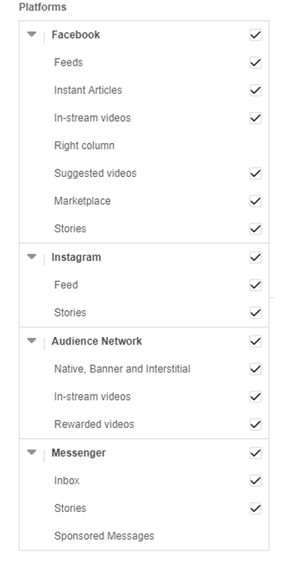

*This post was partially updated in January of 2021.
Successful eCommerce businesses educate their customer (or potential customer) at every point in their journey, from query to purchase. How? Through a stellar content strategy.
Building and maintaining an eCommerce content marketing strategy is not only beneficial for overall customer nurturing, but it also widens the possibilities with SEO. By understanding the true intent behind keywords, online marketers can understand the different needs between potential customers and produce the type of content that will most likely lead to conversions.
Creating a content marketing strategy for eCommerce can often be overwhelming. In this blog post, we’ve given you all the tools to get yours started on the right foot.
Table of Contents
What is eCommerce Content Marketing?
Content marketing is the line that connects the dots between consumers and business owners. Consumers look for specific pieces of information depending on where they are in the buyer’s funnel. Business owners provide that info through content (blogs, videos, and more) answering the consumers’ questions at each step of the funnel.
eCommerce content marketing specifically refers to how an eCommerce brand creates valuable content that appeals to its target audience. The end goal? To provide the content a user needs, wherever they are in the buying funnel, and ultimately lead them to a final purchase.
Whether you’re a B2B or B2C marketer, content marketing campaigns can provide big returns.
How to Create a Content Strategy for eCommerce
Every business is different, which means your content marketing strategy should be unique. You know your customers’ path best, so you know what content will best engage and resonate with them.
But knowing how to translate that into effective content can be difficult. We’ve offered a step-by-step guide to help:
Step 1: Understand Your Customers’ Buying Cycles
Step 2: Identify the Types of Content to Use
Step 3: Create a Distribution Plan
Step 1: Understand Your Customers’ Buying Cycles
When expanding (or starting) a content strategy, you have to first understand your user’s search behavior and how it correlates to your website.
For example, someone searching for “mens hiking boots” is going to require different content than someone searching for “mens Vasque Sundowner” or “Vasque vs Asolo boots.” That’s because all three of these queries have different intent.
The first query indicates that the searcher does not yet know what product they might be interested in purchasing. The next query is typical of someone who knows what they want and is probably shopping by price, stock/availability, etc. The last query (“Vasque vs Asolo boots”) means the consumer has narrowed their choices down to a small set of preferred brands/models — but is looking for some final advice to help them make a more educated decision.
Therefore, each of these search queries requires a different eCommerce content strategy.
“Buying cycles” can help you narrow down your approach. Every good marketer knows that the sales/buying cycle involves multiple stages. We’ve simplified them a bit and tailored them to the specific scenarios encountered in an eCommerce shopping environment.
Uneducated Shoppers Looking for Options
These visitors are in the earliest possible buying stage. They’re searching for options under a core topic, such as “boots” (most general) or perhaps “mens boots” (still general, but more specific). They’re ready to be educated about the various options available to them. Therefore, the content that best suits them should be general and present them with various types of products.
Simply put, these visitors are “browsers.”
You can appeal to these consumers in a number of ways. You could present high-level product types in a browse-and-click format (a category page), or you could write general informative articles about their options in a conversational and helpful manner.
Educated Shoppers Needing Convincing
Conversion rates on initial visits from uneducated shoppers are typically lower than visits from consumers who are further in the buying cycle. However, somewhat-educated shoppers may be ready to “convince themselves” to purchase — and, therefore, have a higher potential for conversion. Your eCommerce content strategy can get them over the initial hump.
Helpful educational content about their options can provide value to the visitor, potentially convert them into a sale, or (at the very least) acquire an email address for later marketing. Whatever the outcome, your eCommerce site is still able to meet business goals through content strategy.
Shoppers Who Know What they Want
Shoppers in this stage of the buying cycle already know what they want — and they’re specifically searching for it with product names. These consumers might not be ready to buy just yet, but they have pinpointed what they (most likely) want.
Thus, conversion rates will be high for product-name keywords, as long as your product pages provide a compelling experience.
Shoppers Needing the Final Push
You might see keywords (in your various metric tools) related to reviews of your eCommerce site, your return or shipping policy, coupons, sales, and other branded keywords. This means a shopper is looking to validate their decision to purchase on your site.
You’ll need to identify these keywords and target them on the right page. Not only will it enable you to match content with the user query (and intent), but it will also help with reputation management.
Shoppers Who Are Ready to Buy
These shoppers are already sold and ready to buy. They are most likely searching for your brand, your store’s hours, address, etc. Make sure all that information is easily available and that your conversion pages are optimized for their use.
Step 2: Identify the Types of Content to Use
Content strategy for eCommerce is about more than optimizing your product and category pages. The best eCommerce stores leverage the power of their blogs, social media, images and video streams to get more eyes on their products and increase conversions.
I briefly mentioned a few ideas above, but there are many other ways you can enhance your eCommerce website strategy and target users at different stages of the buying cycle, such as:
- Buying guides and “how to” content
- Contests and sweepstakes
- Product image galleries
- Product rankings
- Freemiums
- Product comparisons and reviews
- Niche-topic articles and blog posts
- Multi-expert or “round-up” articles
- Online “print” catalogs
- Infographics
- Forums
- User-generated content
- Coupon, discount and sale pages
- FAQ Page
Buying Guides & “How To” Content
Buying guides can help users discover the right products for them. REI does a wonderful job at this via web pages like their How to Choose Hiking Boots guide.
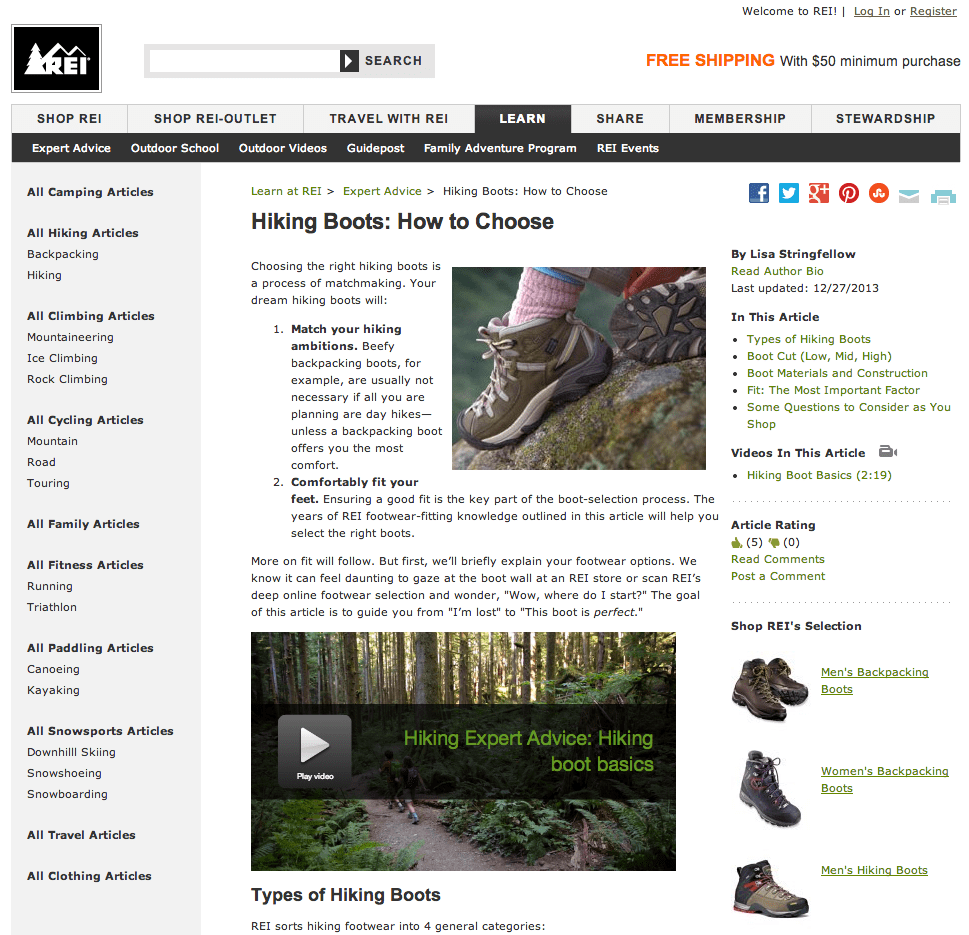

The guide is clearly targeting the keyword “how to choose hiking boots,” which is typically used by someone very early in the hiking boot buying cycle. Boot cut, construction, fit and more are covered in detail, and the user will be much more educated for a buying decision after reading through the guide.
Static links to category pages can be placed within the context of educational content. Related product feeds can be dynamically generated in sidebars (as shown in the right sidebar of the REI page) or perhaps even in between paragraphs to increase the chance of conversion.
Another excellent website content strategy example is the Driveway Repair Guide from Asphalt Kingdom. This “how to” guide provides preliminary information on driveway maintenance to educate readers, tutorials on how to repair your own driveway, answers to common questions, and even a couple of infographics that make the process more visual.
Of course, there are also plenty of links to Asphalt Kingdom products, so a reader can purchase necessary supplies right away.
Contests/Sweepstakes
For the purpose of email acquisition, link-building, social shares, building social followers and increased brand discovery, contests and sweepstakes are a great way for eCommerce websites to get new potential customers into the sales funnel for later email marketing.
Boot Barn, for example, consistently promotes contests on its website, such as this one:
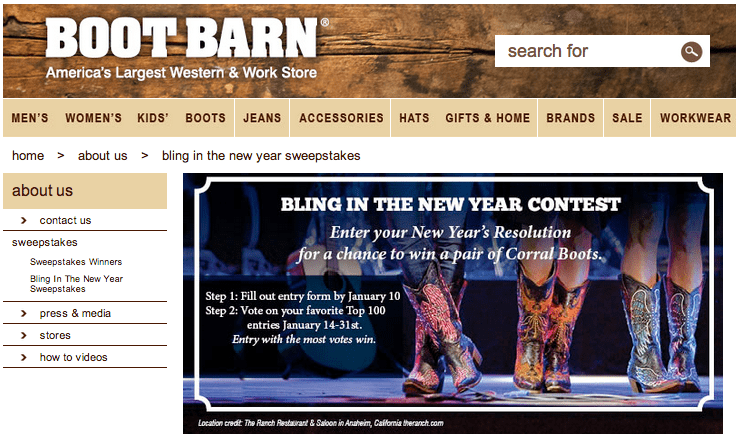

By requiring users to fill out an entry form, BootBarn acquires emails to build its newsletter list for later email marketing. By requiring users to vote on their favorite boots, the business builds engagement with its audience and receives valuable research data.
The possibilities with contests and sweepstakes are endless. “Blog it to Win it” contests can drive links, and “Share to win” contests that can drive social signals and followers. When you couple contest topics with keyword research, you create landing pages that can drive serious organic search traffic to boot.
Pro Tip: Always be sure to check the state and federal sweepstakes laws and write up a Rules/Terms and Conditions page to protect yourself. Be sure to promote your contests and sweepstakes on popular contest websites like www.ilovegiveaways.com for immediate link-building opportunities, and look for contest and giveaway sites within your industry or niche.
Product Image Galleries
Online shoppers are increasingly visual. Consider the popularity and growth of image-based social media channels like Pinterest and Tumblr, and remember that many shoppers use Google Shopping and Google Images to quickly search for products by image.
Build off of these trends by developing image galleries on your site to make the shopping experience more visually executable. Online shoppers love the experience they get on Zara (see below), which features compelling images linking to product pages.


Product Rankings
Looking to other industries for inspiration is always a fun excursion, and there’s something to be learned from the fantasy football industry.
Sites like FantasyPros.com combine player rankings each week and produce an aggregated list. The result? Better decision making for fantasy football players.
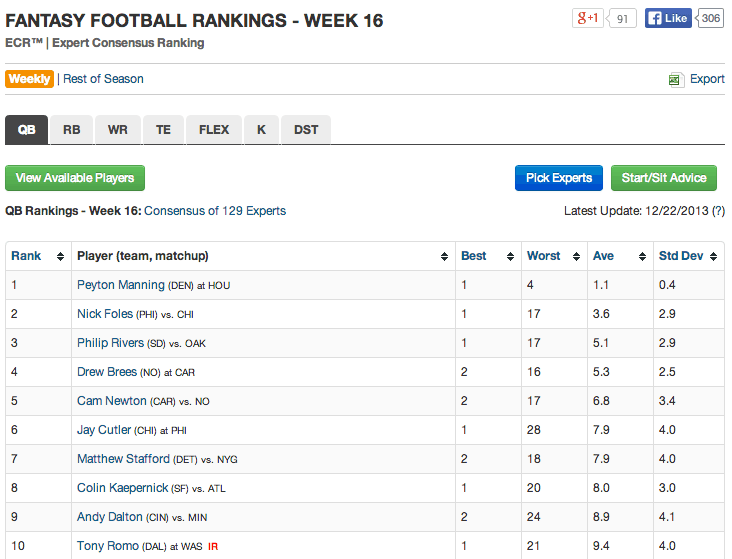

Imagine how this strategy can be applied to an eCommerce store. You likely have ratings, reviews, and data on the most-purchased products in your database. Use that data to create “Best XYZ” pages that list the top 10 products in each category based on rating/review/purchase count, and you’ll have a unique way to target the “Best XYZ” keywords. Not only will this type of content drive traffic, but it should also attract links naturally if your site is one of the few providing such uniquely valuable content.
Freemiums
Offering a free eBook, buying guide, educational white paper, interactive tool, or some other download (aka “freemium”) in exchange for an email address is a great strategy.
One freemium could discuss the pros and cons of different types of products, and another could be an interactive tool that helps users decide what types of products would work for them. While these offers typically satisfy the needs of early-stage consumers, you can use the consumer’s email to later sell products through targeted newsletter marketing.
Here is one example of an HR-focused content site that acquires emails by offering a free, step-by-step guide to HR outsourcing in a downloadable eBook:
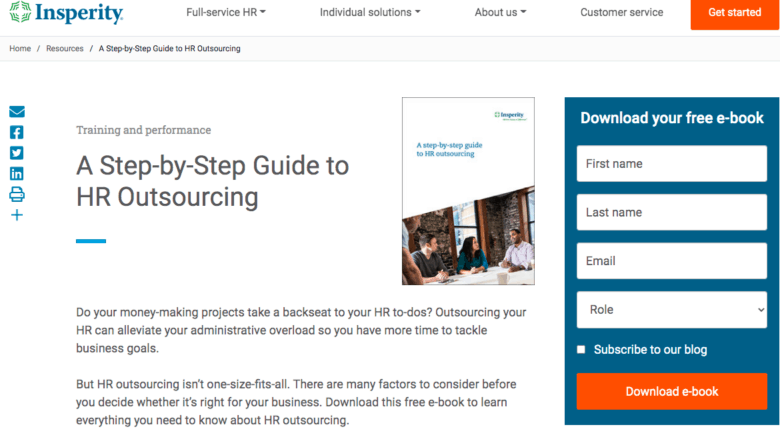

Insperity is funneling new potential customers into their sales cycle by acquiring their email addresses in exchange for a free eBook. In order to attract the right visitors, the business is targeting the keyword “hr outsourcing guide” rather than simply “hr outsourcing” or “human resource outsourcing.” In turn, the page attracts educated visitors who will likely look for HR outsourcing services in the future.
The key to successful freemiums? Attracting the right visitors who have the highest probability of purchasing your products (now or later) once you’ve educated them and built trust in your brand. That’s why we recommend offering freemiums to buyers who are a little further along in the cycle than an uneducated shopper.
Product Comparisons/Reviews
Search queries that compare product A against product B are quite popular with educated shoppers who are looking to learn more. Product comparison matrices, detailed product reviews, and other comparative content targeting later-buying-cycle visitors can be very effective in converting shoppers to buyers.
For example, Apple provides a dynamic comparison chart to help shoppers decide on the right iPhone in this handy comparison chart. One of the more interesting features of this chart is that you can compare 1st generation iPhones all the way up to current models.
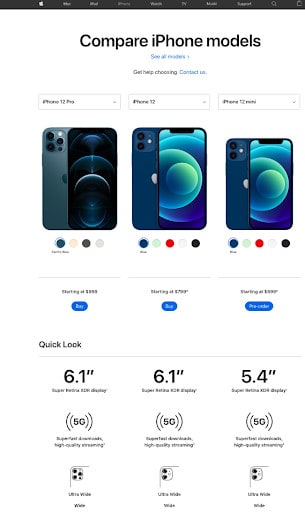

If potential buyers have questions about which model of iPhone is equipped with the right features for their needs, this comparison chart can quickly answer them. Thus, the potential buyer can decide right then and there (on the shopping site) which product is best for him or her — and make the purchase without even leaving the website.
Product comparisons and reviews are also highly effective in video format, as well.
Niche-Topic Articles & Blog Posts
When educated shoppers still aren’t convinced of the right product for them, they tend to use long-tail keywords in their search queries. While these phrases are typically low-volume, they can be very high-intent. You can target those phrases and convert those shoppers to buyers through helpful articles and blog posts.
As a general reminder, blogging isn’t a strategy. It’s simply a means to executing a strategy — in this case, to answer shoppers’ specific queries and educate them about a product. Detailed articles and blog posts are a great way to deliver the message.
Crutchfield does an admirable job at this with articles like Choosing Speakers for Your iPod, iPhone, and iPad.
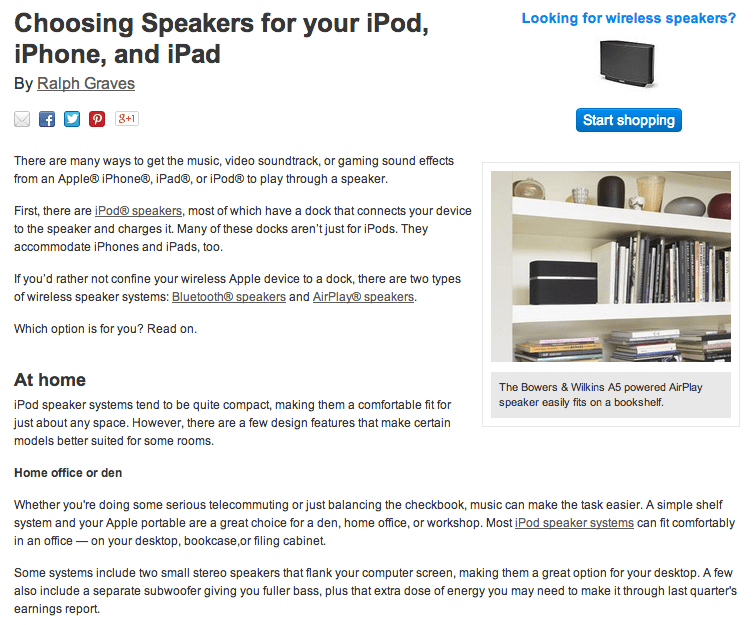

When a user types in search queries like “choosing speakers for an iPod,” Crutchfield ranks on page 1 of Google (partially due to this optimized article, and partially due to their Domain Authority, which allows them to rank well in the first place). They are then able to capture this traffic, educate shoppers and lead them down the purchasing funnel by linking to category pages and displaying related product feeds in the sidebar.
Multi-Expert (aka “Roundup” Articles)
Like niche-topic articles and blog posts, multi-expert content can be delivered in blog post or article format. Unlike the above described niche-topic articles, multi-expert leverages the opinions of experts about a niche topic in order to provide a more trusted stance on a topic.
By leveraging the opinions of others, eCommerce websites benefit from the additional promotion that external experts bring via their own audiences.
One example: Gaia published Daily Rituals: 19 Expert Ways to Find Your Everyday Zen, which helped the website drive more traffic from the contributors’ own social networks and acquire links in the process:


This approach provides additional opportunities for links and social signals. Imagine if Crutchfield curated recommendations from the audio industry’s top experts on how to choose speakers for an iPod, iPhone, or iPad, instead of writing the article themselves. Not only would this potentially be more attractive to the shopper, but it would also provide Crutchfield the opportunity for additional exposure on the contributors’ own websites, Twitter and Facebook accounts, newsletters, and more.
Online “Print” Catalogues
Assuming that your print catalog doesn’t pose duplicate content risks with other content on your site or other sites, consider hosting a PDF version of each month’s (or quarter’s) catalog on your site. The PDF will be crawlable by search engines, and thus, rankable. It’s ideal if the catalog can include links to category and product pages. Assuming your link structure is clean, you could also include links to helpful articles. That way, users who land on the catalog PDF from a search engine can click deeper into your site and potentially make a purchase.
For example, Wayfair posts its seasonal catalog — including furniture, décor, appliances, and storage — on its website.
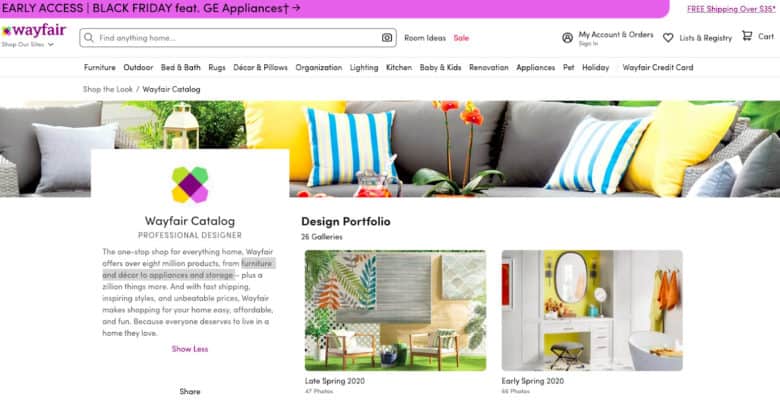

As mentioned, this content must be unique from what already exists on the site. If the content is already being repurposed on the site as articles/blog posts, then it might be best to disallow crawl of the catalog via your /robots.txt and set it to noindex. It can still serve as link bait.
Consider using your catalog as an email acquisition tool, as well.
Infographics
Infographics may get negative attention for overuse, but they’re still a type of content that users enjoy. The key to infographics: Offer unique value to users. Creating very basic infographics or rehashing infographics produced by other publishers is not a good content strategy.
Consider the unique data that you have with your own business and how it might provide value to your audience. You know the most popular items on your website and the most attractive items on clearance. Couldn’t you produce a product-focused infographic to help sell?
Coupons.com did just that with its 2013 Black Friday Most Wanted Items infographic
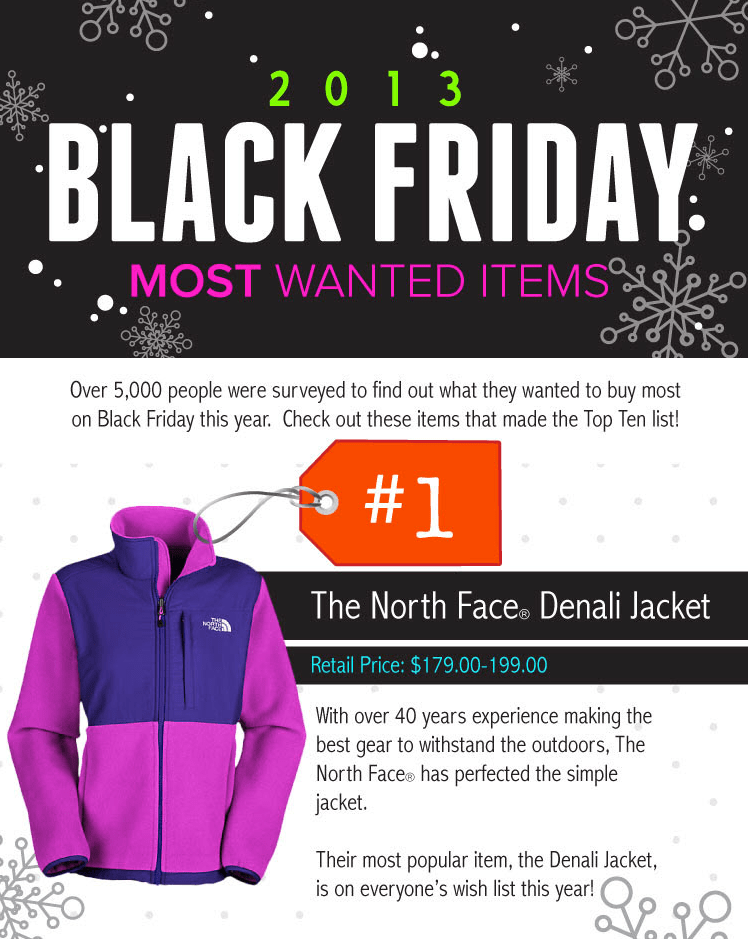

Forums
Your customers have a lot on their minds, and many of them are passionate about what you sell — so why not give them a platform on which to interact?
Many websites are ditching forums in favor of social media, and many argue that forums are hard to monetize. But, as far as we’re concerned, increasing traffic from targeted visitors to your website is certainly not a bad thing.
American Express launched Business Class as a way to allow its small business customers to interact, collaborate, and help each other out. The end result: Increased passion in investing in and growing small businesses. Don’t forget: Investing in a business typically means purchases made on a credit card.
Although direct monetization of forums may not be easily trackable, building a community is worth it.
User-Generated Content
Let your users do the work for you by mining their social feeds and organizing influencer partnerships. There’s likely plenty of high-quality content out there that highlights your products; you just have to find it.
Remember, many shoppers look for validation from their peers: Is someone they know buying from your company? Will your products help them stand out (or fit in) with the social media community? Having an influencer model or promote your products gets new eyes on your brand and amplifies your reach.
You can also go the cost-effective path by searching social hashtags associated with your brand (if you don’t have a branded hashtag, get on that ASAP). Repost aesthetically pleasing and high-performing content featuring your products, or curate and embed posts on to your website.
Just one example: Mountain House, a brand that offers ready-made camping meals, uses the hashtag #savortheadventure and shares beautiful user content frequently on its feeds:
Coupon, Discount & Sale pages
Every customer likes discounts, even yours. Most likely, they are searching your brand name in conjunction with “coupons,” “discounts,” etc.
Why not satisfy these potential customers by optimizing your sales page to use these keywords? Even if you don’t have a sale going on, why not at least offer a small discount to those lucky customers who find the page?
You don’t have to promote it, but if it means making a sale (while retaining a respectable margin), it’s probably worth it.
FAQ Page
Look at historical keyword data for your website and find the how/where/why/when/what keywords that visitors have used to find your site. Understand the questions that users are asking, and answer them on your FAQ page. Make better use of this page by offering creative answers, thorough explanations, and links to category pages and helpful articles.
An FAQ page can provide a great internal linking platform to funnel people into helpful articles and then into the category and product pages. Common topics to cover include your return policy, shipping policy, methods of contact, customer service options, and more. Many visitors to this page could be emotional if they have an issue that needs to be resolved, so be sure to offer help in a nurturing tone and go the extra mile when they end up reaching out.
Step 3: Create a Distribution Plan
Creating content for your eCommerce website does you no good if you can’t successfully promote it. Pages targeting certain keywords may get organic traffic over time but, until then, you need to push out your content through more immediate platforms.
Distribution is a key part of building a content marketing strategy. Don’t leave it to the end, either. Consider how your content will present across channels as you’re planning it, and you’ll save yourself the extra time and effort later on.
Social Media
Social media is far and away one of the most effective ways to reach consumers. But, before you start your campaign, you need to determine which social channels your customers are on, what your goals are, and what resources you can devote to this promotion.
It’s always best to start small: Focus on producing high-quality, engaging content on a few key channels before posting across all social platforms. Measure your results and adjust your campaigns accordingly for the best results.
Building an organic social media strategy for your eCommerce site ahead of time will increase the odds of your awesome new content getting traction and bringing in new customers.
Paid Media
In digital marketing, paid media includes search engine marketing, pay-per-click advertising, and paid social ads. For a price, you can ensure your content is seen by your consumers across search engine results, social media feeds, and more.
Paid media can often be a trial-and-error method. If you try to go too big at the start, you can spend a lot of money for little results. Working with an experienced eCommerce PPC team can maximize your ad spend and ensure your new content strategy isn’t all for naught.
Earned Media
Earned media includes any publicity or promotion from outside sources. It’s the digital word of mouth, such as shares, likes, retweets, mentions and more. When you’ve got quality content, people will share it on their own feeds, amplifying your reach to new audiences.
Remember the multi-expert articles I talked about before? Those are a great way to increase earned media. The experts you interview will often share the article they’ve been featured in, their followers will see your content, and you’ve got a brand-new set of eyes.
Email Campaigns
Finally, don’t forget email campaigns as part of your eCommerce content strategy. Emails offer more opportunities than just promoting your latest sales and newest products. Send out email blasts for newly published shopping guides, upcoming contests and sweepstakes, and more. Just make sure you’re following GDPR rules for email marketing consent.
Build Your eCommerce Content Strategy Now
All of the eCommerce content strategies discussed above are feasible and waiting for implementation on your site. Sure, some changes may need to be made in order to achieve them (i.e. – acquiring talent or hiring an agency like Inflow to assist), but nothing truly “great” happens without effort and change. If the definition of insanity is “doing the same things but expecting different results,” then the only risk you have is falling into obscurity.
So, what are you waiting for? Start building your content marketing strategy today and get ready to see the fruits of your labor with new consumers, increased conversions and more.



